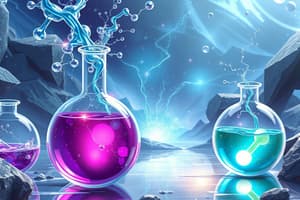Podcast
Questions and Answers
What is the first step?
What is the first step?
Ionic or Molecular
An ionic compound contains a?
An ionic compound contains a?
cation
What is a cation?
What is a cation?
A metal ion or the ammonium ion
What is the second step?
What is the second step?
Acids have the?
Acids have the?
Bases have?
Bases have?
What is a base similar to ammonia?
What is a base similar to ammonia?
All bases are?
All bases are?
If it is neither an acid nor a base, it is?
If it is neither an acid nor a base, it is?
When do we need the third step?
When do we need the third step?
What is the third step?
What is the third step?
How many strong acids are there?
How many strong acids are there?
If it's not on the strong acids list, then it is a?
If it's not on the strong acids list, then it is a?
If it is on the strong acids list, then it is a?
If it is on the strong acids list, then it is a?
Molecular compounds that are neither acids nor bases are?
Molecular compounds that are neither acids nor bases are?
Molecular compounds that are bases are?
Molecular compounds that are bases are?
Strong acids are?
Strong acids are?
Weak acids are?
Weak acids are?
Flashcards are hidden until you start studying
Study Notes
Classification of Electrolytes
- Electrolytes are classified as either ionic or molecular based on their composition.
- Ionic compounds always consist of cations and anions.
Cations
- Cations are positively charged ions, which include metal ions and the ammonium ion (NH4+).
Classification Steps
- The first step is to determine if the compound is an acid, base, or neither.
- Acids are identified by the presence of hydrogen (H) at the forefront of their molecular structure.
- Bases typically involve nitrogen (N) in a configuration similar to ammonia (NH3).
Characteristics of Bases
- A base is characterized by an N atom bonded to either hydrogen (H) or carbon (C).
- All bases are universally classified as weak electrolytes.
Nonelectrolytes
- If a compound does not qualify as an acid or base, it is classified as a nonelectrolyte.
- Molecular compounds that neither act as acids nor bases are categorized as nonelectrolytes.
Acid Classification
- A third step in classification is necessary only when an acid is identified.
- Acids can be further classified as either strong or weak.
Strong Acids
- There are seven recognized strong acids, which act as strong electrolytes in solution.
- If an acid isn't listed among the strong acids, it is deemed a weak electrolyte.
Properties of Molecular Compounds
- Molecular compounds that function as bases are also classified as weak electrolytes.
- Strong acids and weak acids are both considered electrolytes, with strong acids being strong electrolytes.
Summary of Electrolyte Types
- Strong electrolytes include strong acids and ionic compounds.
- Weak electrolytes consist of weak acids and all bases.
- Nonelectrolytes include molecular compounds that do not qualify as acids or bases.
Studying That Suits You
Use AI to generate personalized quizzes and flashcards to suit your learning preferences.




